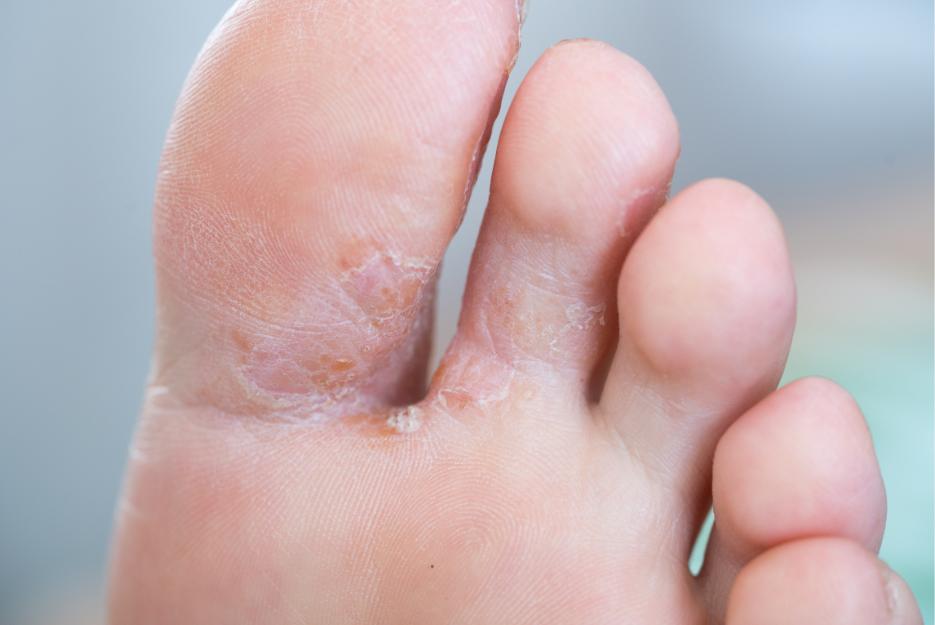Athlete's Foot (Tinea Pedis)
What Is Athlete's Foot (Tinea Pedis)?

Table of Contents
What Causes Athlete's Foot?
Athlete’s Foot can be caused by various types of fungi, with the most common being trichophyton. This fungus thrives in warm, damp environments, which are ideal for its rapid growth and spread. As a result, Athlete’s Foot is often contracted in communal showers, changing rooms, or from wearing closed-in shoes. Australia’s typically hot and humid climate also increases susceptibility to this condition.
The infection spreads through direct contact, meaning it is typically contracted by coming into contact with surfaces where fungal spores have been left by someone who is infected.
Athlete's Foot Symptoms
Signs of an Athlete’s Foot fungal infection may include:
- Red, scaly patches on the skin of the feet
- Cracked or broken skin between the toes, often forming fissures
- Peeling skin on the sole of the foot
- An unpleasant foot odor
- Itching, stinging, or burning sensations
- Changes to the toenails, such as yellow or brown streaks, if the infection spreads to the nails
Visit Us Today
Hope Island
Phone: 07 5510 9222
Located within Hope Island Marketplace Medical & Skin Clinic, 99-103 Broadwater Ave Hope Island QLD 4212
Jimboomba
Phone: 07 5546 9766
Located Within Jimboomba Medical Centre, Unit 1/69 Cerina Cct, Jimboomba QLD 4280
Beenleigh
Phone: 07 3287 2224
Located Within Beenleigh Mall Medical Centre, Shop24A, 40/68 Main Street, Beenleigh QLD 4207
Eagleby
Phone: 07 2889 1666
Located Within Eagleby Family Practice, 5/120 River Hills Rd, Eagleby QLD 4207
Harristown
Phone: 07 4635 6111
Located Within Toowoomba Medical Centre, 146 Drayton Road, Harristown QLD 4350
Marsden
Phone: 07 3067 2370
Located Within Marsden Family Doctors, Shop 28/55-77 Chambers Flat Rd, Marsden QLD 4132
Keperra
Phone: 07 3355 4082
Located Within Keperra Medical Clinic, 14 Dallas Parade Keperra QLD 4054
Coomera
Phone: 07 5573 5663
Located Within Doctors @ Coomera Central, Shop 6, 21 Coomera Grand Drive, Upper Coomera, QLD 4209
Newtown
Phone: 07 4633 8700
Located Within Ochre Medical Centre Wyalla, Shop 20, 238 Taylor Street, Newtown QLD 4350
Tips On Managing Athlete's Foot With Treatment
Before starting treatment, it’s essential to have your podiatrist accurately diagnose the condition, as other skin conditions may resemble Athlete’s Foot. In some cases, both fungal and bacterial infections can occur simultaneously, requiring a tailored treatment approach.
Once a fungal infection is confirmed, it’s crucial to keep your feet clean, dry, and free from sources of reinfection. This may include:
- Thoroughly drying your feet after showering or getting wet, including between the toes.
- Using absorbent powders or antiperspirant sprays to manage excessive sweating.
- Disinfecting shoes, socks, towels, and bath mats to prevent spreading and reduce the risk of reinfection.
- Wearing absorbent socks that promote a dry environment.
- Choosing open or breathable footwear whenever possible to allow the feet to air out.
To address the infection, your podiatrist will recommend the most suitable anti-fungal treatment, which may include creams, sprays, or powders. The choice depends on your specific situation, as certain treatments may be less effective on thickened skin, such as the soles, or in cases of extensive infection.
If the infection has spread to your toenails, causing a fungal nail infection, additional treatment will be required. Treating fungal nails is often more challenging, as the fungus can penetrate the nail bed. Your podiatrist will guide you on the best course of action, which may involve topical or oral medications.
During treatment, extra care is needed as the infection can make the skin fragile and more prone to damage.
Should You Moisturise Athlete's Foot?
What Happens If Athlete's Foot Is Left Untreated?
Will The Infection Come Back?
Athlete's Foot FAQ's
How to prevent Athlete's Foot
Do I need to throw away my shoes if I have Athlete's Foot?
How long can Athlete's Foot live in shoes?
The fungus that causes Athlete’s Foot can survive as spores in the right conditions, remaining viable for months or even years. This is why it’s crucial to actively treat the infection to prevent it from spreading or reoccurring.
Enquire Now
Not The Condition You Are Looking For?
Find out more about the conditions we treat by clicking below.
